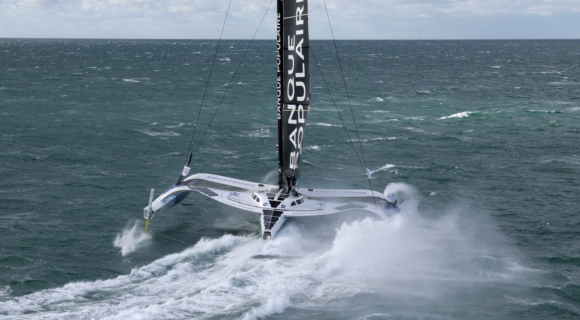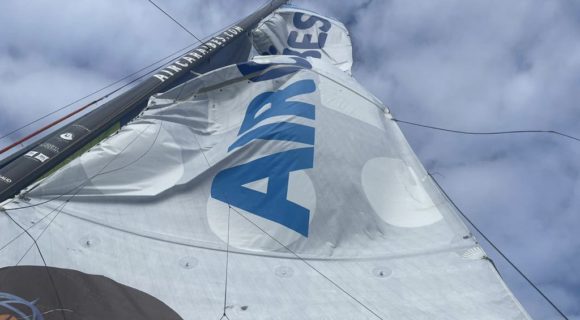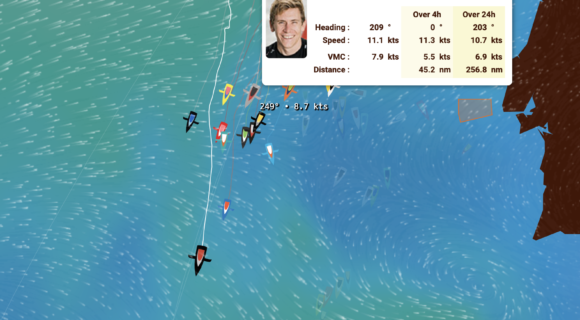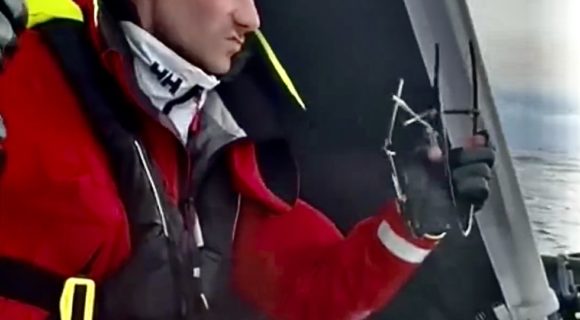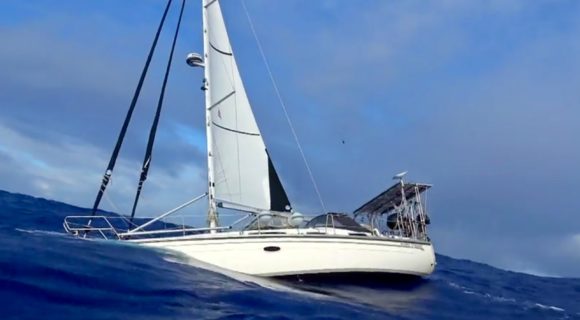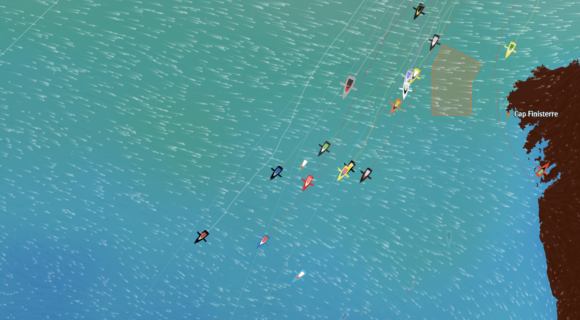Philipp, 28, Hörer unseres Segelmythen-Podcasts SEGELN IST MEER! schrieb: Wie ist Segeln im Winterhalbjahr im Unterschied zum Sommer? In den vorigen Posts gab ich erste Einblicke in die bestimmenden Faktoren Helligkeit/Dunkelheit, Herbstwetter und Segeln im Sturm bis 43 Knoten. Ich war froh, danach heil im Hafen von Izola gelandet zu sein. Aber damit wars immer noch nicht getan…

Die Marina In Izola am vergangenen Samstag um 07.00 Uhr Morgens. Eineinhalb Tage nach meinem Sturm-Erlebnis im vorigen Post liegt tiefer Frieden über der Nordmole und der Einfahrt in die Marina. Nichts deutet darauf hin, dass das nächste Sturmereignis für diesen Tag bereits im Anmarsch ist.
In meinen Gewitterseminaren teile ich oft meine Einschätzung mit, dass Wetterextreme und Gewitter weniger lokal begrenzt Ereignisse sind, als die wir sie häufig aus unserem eng begrenzten lokalen Blick erleben. Und Gewitterlagen – also Situationen, die die Entstehung von Gewittern und Unwettern begünstigen, häufig nicht mit dem einzelnen, sprichwörtlich „reinigenden“ Gewitter erledigt sind.
Das Unwetter, das mir zwei Tage zuvor auf See Südost, also „Jugo“, zwischen konstant 35 und mehr als 40 Knoten beschert hatte, war mit diesem Ereignis längst nicht erledigt. Für den folgenden Samstag meldeten die Wetterdienste tagsüber ruhiges Wetter. Doch ab 20 Uhr steigenden Wind, der im 4 Segelstunden entfernt liegenden Grado in Spitzen bis 50 Knoten erreichen sollte. War das ein neues Unwetter? Oder gehörte es erneut zu einem der großen Tiefdrucksysteme vor Irland, die in der Folge auch die verheerenden Ereignisse an der Ostsee nach sich zogen und bis in die nördliche Adria reichten?

Ich hatte überlegt, das kurze Wetterfenster zu nutzen und bis 20 Uhr in meinen Heimathafen San Giorgio di Nogaro zurückzukehren. Es wären ja nur fünfeinhalb Stunden. Noch um 15 Uhr am Samstag Nachmittag war alles ruhig, ich war kurz davor, die Leinen loszuwerfen, „was soll schon passieren, ich bin die Strecke x-mal gefahren, da husche ich schnell vorher durch.“
Ich tat es nicht. Das viel gerühmte Bauchgefühl? Ich weiß es nicht. Ich getraue mich nicht, mich mit meinem 6. Sinn zu brüsten. Oder dem von Bergführern oft erwähnten Bauchgefühl, der Summe aller unserer Erfahrungen, die unseres Inneres „matcht“ mit den aktuell vorliegenden Daten und bei Nichtübereinstimmung der neuen mit den alten Daten ein miserables Bauchgefühl erzeugt.
Ich blieb, wo ich war. Legte bei Sonnenuntergang eine zusätzliche Leine von der Mittschiffsklampe zu meinem Standort auf der Pier auf dem Foto oben. Pünktlich um acht begann es in den Wanten zu sirren aus Südost. Als ich mich eine Stunde später mich in meiner Koje schlafen legte, schien es, als würden sie mit jeder Minute lauter singen.
Gegen 2 Uhr Nachts erwachte ich. Ein ungewöhnliches Heulen über dem Hafen von Izola. Nein, nicht der Wind, obwohl der den harten Bootsbewegungen nach längst in den 30ern von den Hügeln Izolas im Südosten herunter tobte. Nein, das Geräusch war etwas anderes. Der durchdringende, nicht mehr endende Ton einer Sirene. Ich dachte kurz nach. Obwohl ich von 2009 bis 2014 Levje in dieser Marina liegen hatte und den Ort gut kannte, war das neu. Was war das? Es ging über mehrere Minuten. Irgendwann dämmerte mir: „Steh auf. Das muss eine Flutwarnung sein. Der Ort wird möglicherweise überflutet.“
Wie ich war, zog ich das Schiebeluk auf. Prasselnder Regen trommelte auf die Sprayhood, an der der Wind rüttelte. Ich leuchtete mit der Taschenlampe zur Pier hinüber, die man im Bild oben gut erkennt. Izola ist ein Gezeitenhafen mit 0,70-1,20 Meter Tidenhub. Doch jetzt stand das Wasser knapp unter der Kante der Pier. Die Vorleinen ragten nun steil nach unten. Ich spurtete ohne Nachzudenken in Unterhose durch das Geprassel zum Bug, um die Leinen zu kontrollieren. Sie waren hart gespannt und hatten bereits begonnen, das Vorschiff tiefer ins Wasser zu ziehen. Der Kopfschlag war hammerhart zugezogen, ich hatte Mühe, ihn mit nassen Fingern soweit zu lösen, dass ich fieren und den Druck auf die Klampen wegbekommen konnte. Lose trieben Passerellen, Polster und Gangway-Bretter im Hafenbecken, die der Wind Richtung Nordmole weitertrieb. Ich löste beide Vorleinen. Aber der Winddruck war erneut unheimlich. In der Spitze waren es wie schon in den Vortagen knapp über 40 Knoten.
Reichten die Vorleinen? Ich hatte das Gefühl, eine weitere lange Leine zur Steuerbord-Mittschiffsklampe könnte die beiden ächzenden Vorleinen entlasten. Doch mein Bug befand sich wegen des Hochwassers zu hoch über der Pier, es kostete mich einige Überlegung, bis ich den Anker aus seiner Halterung etwas fallen ließ und mich daran, immer noch halbnackt, auf die Pier ließ. Schnell die neue Leine festmachen. „Sieh zu, dass du wieder auf dein Schiff kommst und die Leine belegst.“ Ich sah noch eine Weile zu, ob mein Gedanke mit der Achterspring der richtige war. Zumindest bei dieser Windrichtung lag das Schiff ruhiger.
Ich rieb mich trocken unter Deck. Aber es dauerte lange, bis ich ich die Kälte aus meinem Körper brachte, selbst unter zwei Bettdecken. Das Heulen der Sirene hatte längst aufgehört, als ich einschlief.

Und die 50 Knoten in Grado? Als ich am Sonntagnachmittag in San Giorgio eintraf, hatte der Südwest immer noch 6 bft. geblasen. Das richtige für eine schnelle Überfahrt. Doch in der Marina Sant‘ Andrea sah man am Spülsaum mit den angespülten Holztrümmern und Schilfgräsern, dass das Unwetter dort die Betonpier um 50 Zentimeter überspült und die Stromversorgung in Teilen lahm gelegt hatte.
Wie in der Marina Izola war es im Hafen sonst bei im Wasser treibenden Gangwaybrettern geblieben. Ich wundere mich immer noch, dass bei derartigen Extremsituationen in Marinas nicht mehr passiert. Und ein richtig ausgeführter Kopfschlag reicht, um an 700 Booten größere Schäden zu verhindern.
Wer mehr über meine Erfahrungen das Wetter in Kroatien erfahren will: Heute Donnerstag den 9.11. um 19.30 Uhr berichte ich über das, was ich in diesem Herbst über DAS WETTER IN KROATIEN gelernt habe.
Am Donnerstag, den 30. November um 19.30 Uhr spreche ich über STARKWIND-TAKTIK AUF DER ADRIA. Wie kann man bei 43 Knoten noch segeln? Was ist die richtige Taktik? Wie geht man mit der Angst um? Der eigenen? Und der der Crew?





